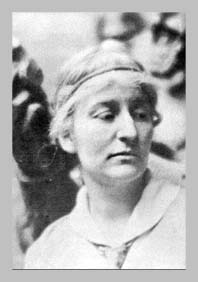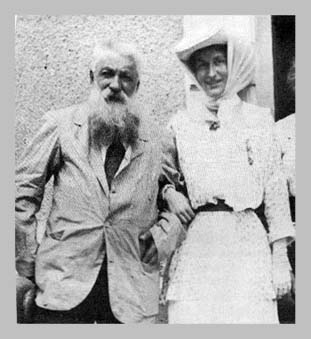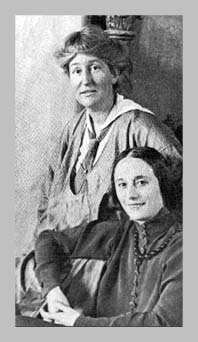MALVINA HOFFMAN
A Tribute
Born - June 15 , 1887  Died - July 10, 1966
Died - July 10, 1966

 Born in New York,
Malvina was the daughter of Richard Hoffman, a music teacher
who began life as a child prodigy of the piano, later the solo
pianist for the New York Philharmonic Orchestra.
Born in New York,
Malvina was the daughter of Richard Hoffman, a music teacher
who began life as a child prodigy of the piano, later the solo
pianist for the New York Philharmonic Orchestra.
 At an early age she was attracted to the
arts, possibly because of the many great opera stars that visited
their home,
At an early age she was attracted to the
arts, possibly because of the many great opera stars that visited
their home,
 In 1908 she first met Samuel Grimson. The
violinist had come to play chamber music recitals with her father,
sixteen years later in June of 1924 they were married. Her fathers
failing health inspired Malvina to attempt to make an adequate
portrait of her father and began oil painting. Oils did not seem
adequate, she felt that it required a three dimensional form
and began to sculpt his head. She studied drawing and painting
while still at the Brearley School and for several years worked
under the direction of John W. Alexander.
In 1908 she first met Samuel Grimson. The
violinist had come to play chamber music recitals with her father,
sixteen years later in June of 1924 they were married. Her fathers
failing health inspired Malvina to attempt to make an adequate
portrait of her father and began oil painting. Oils did not seem
adequate, she felt that it required a three dimensional form
and began to sculpt his head. She studied drawing and painting
while still at the Brearley School and for several years worked
under the direction of John W. Alexander.
 She completed a marble bust of her father,
which she sent to the National Academy where it was exhibited.
She completed a marble bust of her father,
which she sent to the National Academy where it was exhibited.

 After
her father's death, she traveled to Europe with a letter of introduction
from Gutzon
Borglum to Auguste
Rodin. It took her five attempts at presenting the letter
before Rodin would see her. It included photographs of two busts
that she had done, one of her father and the other of the man
she was to marry. Rodin recognized her talent immediately. Her
acceptance as a pupil by Rodin began a friendship that would
last until the end of his days.
After
her father's death, she traveled to Europe with a letter of introduction
from Gutzon
Borglum to Auguste
Rodin. It took her five attempts at presenting the letter
before Rodin would see her. It included photographs of two busts
that she had done, one of her father and the other of the man
she was to marry. Rodin recognized her talent immediately. Her
acceptance as a pupil by Rodin began a friendship that would
last until the end of his days.
 By 1915, Hoffman had achieved some fame of
her own. She went on to become a master founder in order to cast
her own bronzes, including the heavy lifting, generally left
to foundry workers. She later published a technical book that
included information on bronze casting, "Sculpture: Inside
and Out".
By 1915, Hoffman had achieved some fame of
her own. She went on to become a master founder in order to cast
her own bronzes, including the heavy lifting, generally left
to foundry workers. She later published a technical book that
included information on bronze casting, "Sculpture: Inside
and Out".
 She approached her task with a commitment
to capturing the individual spirit of each subject.
She approached her task with a commitment
to capturing the individual spirit of each subject.
 The Paris experience brought her into a
circle of sculptors and artists like Constantin
Brancussi and Ivan
Mestrovic, Paderewski,
Anna Pavlowa,
Gertrude
Stein and Claude
Monet. Mestrovic gave her the advice that she must learn
the principles and the technical side of sculpture better then
most men, because of the preconceived idea that a woman could
not get serious about her art. Rather then deter, this inspired
her to learn all facets of her field of art.
The Paris experience brought her into a
circle of sculptors and artists like Constantin
Brancussi and Ivan
Mestrovic, Paderewski,
Anna Pavlowa,
Gertrude
Stein and Claude
Monet. Mestrovic gave her the advice that she must learn
the principles and the technical side of sculpture better then
most men, because of the preconceived idea that a woman could
not get serious about her art. Rather then deter, this inspired
her to learn all facets of her field of art.
 In 1919 Malvina traveled to the Balkans
on behalf of the American Relief Administration to gather information
on the hospital and children's centers.
In 1919 Malvina traveled to the Balkans
on behalf of the American Relief Administration to gather information
on the hospital and children's centers.
 In 1930, Stanley Field, the nephew of Marshall
Field I, commissioned Malvina to sculpt and cast bronze figures
depicting the peoples of the world, this was to be her greatest
project and achievement, the creation of " The Hall of Man"
for the Field museum of Chicago. "The Races of Mankind"
is the largest singly commissioned body of her work and consists
of 104 busts, heads and life-sized figures. In preparation for
the exhibit, Hoffman and her husband, S. B. Grimson, traveled
throughout the world to find authentic models for the sculptures.
It took five years to complete. The one hundred bronzes which
make up the "Races of Man" is an incomparable collection
of the various racial types of man inhabiting this world. The
work was very controversial amongst the anthropological circle
of the time. Her work was criticized by social scientists as
too reliant on physical over cultural characteristics. Her bronzes
of the Sengalese Tom-tom Player
and the Shilluk Warrior are examples
of the character she was able to portray in these sculptures.
The prevailing abstract artists of the day saw her work as either
too realistic or too romantic. By the time of her death in 1966,
figures such as her Nordic Type or Bushman Man were dismissed
as anthropologically incorrect, and her work was moth balled.
In 1930, Stanley Field, the nephew of Marshall
Field I, commissioned Malvina to sculpt and cast bronze figures
depicting the peoples of the world, this was to be her greatest
project and achievement, the creation of " The Hall of Man"
for the Field museum of Chicago. "The Races of Mankind"
is the largest singly commissioned body of her work and consists
of 104 busts, heads and life-sized figures. In preparation for
the exhibit, Hoffman and her husband, S. B. Grimson, traveled
throughout the world to find authentic models for the sculptures.
It took five years to complete. The one hundred bronzes which
make up the "Races of Man" is an incomparable collection
of the various racial types of man inhabiting this world. The
work was very controversial amongst the anthropological circle
of the time. Her work was criticized by social scientists as
too reliant on physical over cultural characteristics. Her bronzes
of the Sengalese Tom-tom Player
and the Shilluk Warrior are examples
of the character she was able to portray in these sculptures.
The prevailing abstract artists of the day saw her work as either
too realistic or too romantic. By the time of her death in 1966,
figures such as her Nordic Type or Bushman Man were dismissed
as anthropologically incorrect, and her work was moth balled.
 Gradually, in the years since, critics and
the museum itself have taken a different view, seeing in Hoffman's
work not a simplification of ethnic types but extraordinary recreations
of vibrant individuals from different cultures. The figures reveal
more than mere technical prowess and anatomical detail; they
express a feeling of movement, ready at any moment to spring
forth. Malvina's subjects, frozen in a moment of time, in joyous
motion or deepest concentration, exude life.
Gradually, in the years since, critics and
the museum itself have taken a different view, seeing in Hoffman's
work not a simplification of ethnic types but extraordinary recreations
of vibrant individuals from different cultures. The figures reveal
more than mere technical prowess and anatomical detail; they
express a feeling of movement, ready at any moment to spring
forth. Malvina's subjects, frozen in a moment of time, in joyous
motion or deepest concentration, exude life.
 The resulting photographs from the trip
appear in her two autobiographies, as well as in several publications
about Malvina Hoffman Malvina was a member of The Association
of Women Painters and Sculptors, which changed its name in 1917,
to The National Association of Women Painters and Sculptors,
and in 1941, to their present NATIONAL ASSOCIATION OF WOMEN ARTISTS,
INC.
The resulting photographs from the trip
appear in her two autobiographies, as well as in several publications
about Malvina Hoffman Malvina was a member of The Association
of Women Painters and Sculptors, which changed its name in 1917,
to The National Association of Women Painters and Sculptors,
and in 1941, to their present NATIONAL ASSOCIATION OF WOMEN ARTISTS,
INC.
 Malvina
Hoffman died at her studio-home in New York, New York, on July
10, 1966.
Malvina
Hoffman died at her studio-home in New York, New York, on July
10, 1966.

Malvina with her close friend Anna Pavlowa.

|
Sculpture Inside and Out Heads and Tales Yesterday Is Tomorrow Two Sculptures from the "Hall of Man" |